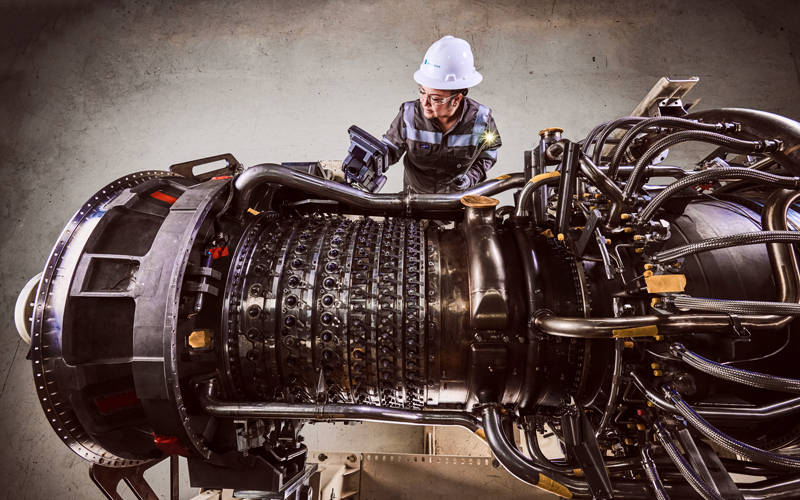View from the top: Scott Strazik, CEO, GE Vernova
Scott Strazik talks to Energy Focus about the company’s strategies and innovations driving the global energy transition, emphasising the need for urgent action, collaboration and technological diversity.

GE Vernova is at the forefront of the energy transition. What are the key pillars of its vision for a sustainable and resilient energy future?
We think about the energy transition as a period similar to the industrial and digital revolutions in terms of global importance and impact – a multi-decade supercycle of huge transformation and growth. Our mission is focused on building a more sustainable electric power system, meaning we must urgently grow and transform an infrastructure that has been built up over a century, using the technology of today while developing the breakthrough technologies of tomorrow. As demand for electricity increases, it offers an opportunity to sustainably rewire the global economy – and we are ready to deliver.
Our Sustainability Framework includes four pillars; GE Vernova is the only company to include Electrification as part of its framework, as well as Decarbonise, Conserve and Thrive. Our leadership position in providing equipment and services that can deliver on the energy transition is one we take seriously in terms of conserving the planet’s resources and ensuring an equitable future. Around 750 million people lack electricity today, and not much can happen without it: healthcare, education, sustainable growth.
Can you outline the key strategies your company is employing to manage and accelerate the energy transition across different sectors?
We believe in an ‘all-of-the-above’ technology approach, which can balance the energy trilemma – to provide reliable, affordable, sustainable and secure electricity. GE Vernova provides essential products and solutions for the world’s electricity systems across our three segments: power, wind and electrification. The businesses in these segments allow us to help generate, transfer, orchestrate, convert, and store electricity with the scope and scale needed to lead the energy transition. With global electricity demand expected to double by 2040, the breadth of our portfolio means we are positioned to provide an enormous impact. Many of the world’s leading utilities, developers, governments and large industrial electricity users rely on our installed base today, which generate approximately 25% of the world’s electricity.
How is GE Vernova integrating renewable energy sources into traditional energy systems?
Renewable energy technologies such as wind and solar, and other zero emissions technologies such as nuclear, have an important role to play both today and tomorrow in helping us to decarbonise the electric power system, and we are deeply committed as a leading provider of renewable energy technologies. More broadly, though, the focus across our portfolio is to help customers meet their growing demand for electricity generation as sustainably as possible, with technologies that help them avoid, reduce or capture greenhouse gas emissions when generating electricity.
What are some of the most significant technological innovations GE Vernova is developing or implementing to support the transition to cleaner energy?
We continue to build on a rich heritage of technology leadership and innovation, dating back to Thomas Edison’s first commercial power plant in the US in 1882. Today we invest around US$1bn annually in R&D, often with partners or other third parties. These efforts drive breakthroughs across a range of technologies, such as energy storage, hydrogen, carbon capture, the BWRX-300 (a small modular nuclear reactor) and electricity software. Our role is to deliver state-of-the-art technology across the energy mix, enabling customers to meet their long-term sustainability goals.
Could you share some specific sustainability goals GE Vernova has set, and the progress made towards achieving them?
We announced our Sustainability Framework earlier this year, and in the autumn we’re launching GE Vernova’s first Sustainability Report, detailing our progress, goals and commitments towards building a more sustainable power system. Our focus is on being a leader in providing electricity generation, enabling decarbonisation of the electric system (while growing capacity), and making progress on our pledge to achieve carbon neutrality for our Scope 1 and 2 emissions by 2030. We’ve also developed a product stewardship and circularity strategy, known as our 4R circularity framework, and our goal is for it to cover 90% of our top products (by sales) by 2030. Finally, we focus on people, with goals for safety, inclusion, ethics and human rights.
The recent spin-off from GE is a significant milestone for GE Vernova. How has it impacted operations, and what new opportunities does it present for the company?
GE Vernova is a purpose-built energy technology company focused on accelerating electrification and decarbonisation. We’re excited by our progress since our April 2024 spin-off, and for the opportunity ahead. Our portfolio gives us unique scope and scale and better positions us to collectively accelerate the energy transition. We have more than 75,000 employees across over 100 countries with the sole focus of serving customers and helping them navigate the challenges of maintaining more secure, sustainable, reliable and affordable power systems.
As an independent company, this focus has increased our agility so we can respond better to industry dynamics and the increasing demand for power generation, driven by several factors and market dynamics across the world – including manufacturing growth, industrial electrification, electric vehicles, emerging data centre needs, and secure and reliable grid infrastructure. Our purpose is not just transforming the power and energy sectors, but enabling the energy-reliant industries of tomorrow to grow and innovate.

What roles do partnerships and collaborations play in GE Vernova’s strategy for managing the energy transition?
No single company can drive or deliver the massive scale of what the energy transition will require. We see ourselves as a leading entity at the centre of this transformation, collaborating with customers, universities, policymakers, smaller startups and venture capital to drive the critical breakthroughs in the energy transition that smaller organisations cannot. We have the scale and industrial footprint to help innovate, develop and scale the products and solutions required to electrify and decarbonise the world today and tomorrow. We’ve located our global headquarters in Cambridge, Massachusetts, in a hub of talent, technology and innovation, and we’re dedicated to unlocking growth in collaboration with all our stakeholders.
How is GE Vernova engaging with policymakers and regulatory bodies to support the transition?
We work closely with governments around the world on their unique needs and believe public-private partnerships are essential to the transition – we’ve been proud to be at the centre of private sector engagement from COP28 to the successful implementation of clean energy tax credits in the US. We also want to focus on meeting the requirements of emerging economies, which have different needs to those with more fully developed energy infrastructures. From working with the Ministry of Energy in Ukraine on its short and long-term needs, to helping fortify the grid among huge electrification demands in Africa, to accelerating coal-to-gas switching in southeast Asia, we are providing expertise and technology around the globe. As the private and public sectors look for more partnership opportunities throughout the energy transition, I’m confident we will see a force multiplier that accelerates the work to electrify the world while decarbonising it.
What changes in regulations or policies do you believe are necessary to accelerate the transition to sustainable energy?
We support recent policy trends focused on partnership and empowerment with the private sector. These approaches have accelerated not just technology deployment, but also jobs and manufacturing. This is a good start, but we have work to do on driving policy certainty by making these goals of electrification and decarbonisation apolitical, and pursuing permitting and infrastructure reform that ensure we can realise the full potential. Permitting reform and the ability to move projects forward more efficiently is important, as are policies that encourage innovation, such as further development of alternative fuels, building the grid of the future, or dozens of other R&D projects we are working on at our Global Research Centers and other facilities around the world.

How is GE Vernova preparing its workforce for the new skills required in a transitioning energy landscape?
Our team of more than 75,000 employees is our greatest asset and we’re dedicated to investing in their skills and abilities as we lead the energy transition. The GE Vernova Way, the principles we run our company on, prioritises Safety, Quality, Delivery and Cost – with safety coming first – for employees, contractors, customers and other stakeholders. We see the GE Vernova Way as a potential differentiator, as it ensures we deliver effective, measurable and sustainably successful outcomes for customers, employees and other stakeholders.
We have more work to do on driving policy certainty by making these goals of electrification and decarbonisation apolitical and pursuing permitting and infrastructure reform
Outside of our company, the new GE Vernova Foundation is committed to developing the workforce of the future to support the energy transition. Its programmes will invest in both the future and the present, encouraging young people to pursue STEM and skilled trade careers, and provide reskilling and upskilling support to ensure no worker is left behind during the transition. The foundation’s investments will help to bridge the global skills gap to ensure a sustainable transition.
What emerging trends or technologies do you believe will have the most significant impact on the energy transition in the next decade? And how does GE Vernova plan to stay ahead of these trends and continue to lead in the energy sector?
First, we need to act with urgency. We need to use today’s technology to drive action and meaningful change. But we’re just as focused on developing and commercialising the breakthrough energy technologies of tomorrow, including energy storage, hydrogen, carbon capture, small modular nuclear reactors, advanced wind turbines and electricity software. We don’t think there is a single ‘silver bullet’ technology; we believe in an ‘all-of-the-above’ approach, prioritising a diverse set of technologies that suit global customer requirements while balancing the energy trilemma.
We see the technology developments in the electric power industry as an incredibly exciting place to play; our responsibility is to be the architects, engineers and builders of a sustainable energy future.
About
Scott Strazik
Scott Strazik is CEO of GE Vernova. He has more than 20 years of finance, operations and leadership experience with GE, including more than eight years in the company’s power businesses.
Before joining GE Power, Mr Strazik held various senior roles, including as CFO of GE Aviation’s Commercial Engine Operations and CFO of Gas Power Systems. He was also instrumental in the launch of GE’s HA gas turbine – one of its most successful new product introductions.
Mr Strazik became an officer of the General Electric Company in 2015 and served as President and CEO of its Power Services business in 2017. Having been appointed CEO of Gas Power in 2018, he expanded his role to leading GE Power businesses from 2021.
Mr Strazik holds a BA in Industrial Labour Relations from Cornell University, and a master’s from Columbia University’s School of International and Public Affairs in Economics and Public Policy.
Image Credit | iStock – Shutterstock – various | Chris - Rank - Rank - Studioa






Follow us
Advertise
Free e-Newsletter